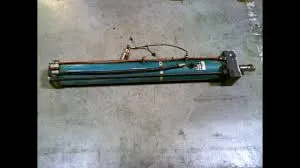Dec . 15, 2024 14:18 Back to list
High-Performance Single-Acting Hydraulic Cylinder for Versatile Applications and Efficiency
Understanding One-Way Hydraulic Cylinders A Key Component in Hydraulic Systems
Hydraulic systems are pivotal in the world of machinery and industrial applications, enabling a vast array of tasks that require power and precision. Among the various components of these systems, one-way hydraulic cylinders stand out for their unique functionality and applications. This article will delve into the principles, construction, working mechanism, and applications of one-way hydraulic cylinders, elucidating their critical role in hydraulic systems.
What is a One-Way Hydraulic Cylinder?
A one-way hydraulic cylinder, also known as a single-acting cylinder, is a type of hydraulic actuator that converts hydraulic energy into linear mechanical work. Unlike double-acting cylinders that can operate in both directions, one-way cylinders exert force in a single direction while relying on a spring or gravitational force to return to their original position. This configuration makes them particularly suitable for specific applications where force is needed in one direction.
Construction and Components
One-way hydraulic cylinders are relatively simple in design, comprising several key components
1. Cylinder Barrel This is the main body of the cylinder, where hydraulic fluid is contained. It is typically made of high-strength steel to withstand internal pressures.
2. Piston The piston moves within the cylinder barrel, creating a pressure differential that generates force. It is sealed to prevent hydraulic fluid from leaking and is designed to handle high-stress conditions.
3. Rod Attached to the piston, the rod extends out of the cylinder and connects to the external load. The design ensures that the rod can withstand tensile forces while allowing smooth movement.
4. End Caps These seal the ends of the cylinder, with one end allowing the piston rod to extend and retract. The other side is where hydraulic fluid enters.
5. Spring (or Load) In a one-way hydraulic cylinder, a spring or an external load can be used to return the piston to its original position after the hydraulic pressure is released. The spring provides a predetermined force that pushes the piston back when the fluid is no longer pressurizing the cylinder.
Working Mechanism
one way hydraulic cylinder product

The operation of a one-way hydraulic cylinder is straightforward. When hydraulic fluid is pumped into the cylinder, it enters from one end, exerting pressure on the piston. This pressure causes the piston to move in the desired direction, effectively performing work as it exerts force through the rod.
As the piston moves, it compresses the spring (or acts against a load), which stores energy. When the hydraulic fluid is released, the spring pushes the piston back to its original position, allowing for repeated cycles of movement.
Applications
One-way hydraulic cylinders are extensively used across various industries due to their efficiency and simplicity. Some notable applications include
1. Forklifts In forklifts, one-way hydraulic cylinders are used to lift the forks. Once the hydraulic pressure is removed, the weight of the load or a spring mechanism brings the forks back down.
2. Mechanical Presses In manufacturing, one-way cylinders are crucial for mechanical presses, helping to apply consistent force to materials during shaping or cutting processes.
3. Agricultural Equipment Many agricultural machines utilize one-way hydraulic cylinders for tasks such as lifting plows, adjusting mowers, and operating various lifting mechanisms.
4. Construction Machinery Excavators, backhoes, and bulldozers often use one-way hydraulic cylinders to control the movement of their arms and blades, allowing for precise operations.
5. Automotive Lift Systems Car lifts employ one-way hydraulic cylinders to elevate vehicles for maintenance and repairs, utilizing gravity to lower them safely back down.
Conclusion
One-way hydraulic cylinders are essential components of hydraulic systems, offering efficiency and reliability across a wide range of applications. Their straightforward design and functionality make them indispensable in industries such as manufacturing, agriculture, and construction. Understanding how these cylinders work and where they are used can greatly enhance the effectiveness of hydraulic systems, facilitating the seamless operation of machines that perform vital tasks in our daily lives. As technology advances, one-way hydraulic cylinders will undoubtedly continue to evolve, enhancing their capabilities and applications in various fields.
-
Fork Lift Power Units - Hebei Shenghan | Efficiency, Reliability
NewsJul.13,2025
-
1.5-Ton Turbocharged Cylinder-Hebei Shenghan|Hydraulic Solution,Energy Efficiency
NewsJul.13,2025
-
Auto Hoist Power Units-Hebei Shenghan|Efficiency&Industrial Lifting
NewsJul.13,2025
-
Double Acting Power Units-Hebei Shenghan|Hydraulic Solutions,Industrial Efficiency
NewsJul.13,2025
-
1.5 Ton Lifting Cylinder 70/82-40-290-535 - High-Performance Hydraulic Solution | Hebei Shenghan
NewsJul.13,2025
-
Fork Lift Power Units - Hebei Shenghan | Efficiency&Reliability
NewsJul.13,2025
